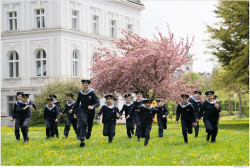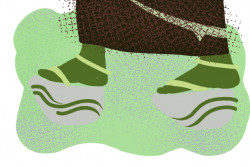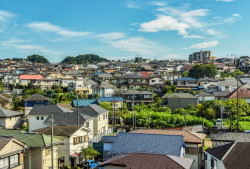

Inside Watanabe's office. Dreux Richard

New Sky Building #3 from the street. Courtesy Takeshi Sato

Dragon Fort. Dreux Richard

Isamu Yamadera on the roof of The Dragon Fort. Dreux Richard
Remaining major works
New Sky Building #3, Shinjuku; Watanabe Architectural Office, Hirakawa-cho; House of Ikago, Kichijoji; Dragon Fort, Ito area, Shizuoka-ken; Zendo-ji temple, Itoigawa, Niigata-ken; Diagonal House, Joetsu, Niigata-ken; Farm House in Snowy Country, Joetsu, Niigata-ken.
His own words
In fulfillment of his last wishes, a bilingual retrospective of Watanabe’s work was published posthumously by Shinkenchikusha in 1985. The few books printed have all but disappeared, but a copy is available for reading at Yoshioka Library, provided you call ahead. 2-31-2 Yushima, Bunkyo-ku, Tokyo. Tel: 03-3811-7101. Nearest stn: Yushima.
The line that separates paragons from pariahs can be thin, and Watanabe tap-danced upon it. His inexhaustible fervor was subject to compulsion, and resulting lapses in judgment cost him.
At Waseda, close friendships with Yoshizaka and his successor, Yoshiro Ikehara, insulated Watanabe from the potential consequences of his unprofessional behavior. But when he initiated a physical altercation with several of his students during class, it proved too much for Ikehara to deflect, and Watanabe was fired. It was a regrettable end to an impactful teaching career in which he regularly took students on “kamikaze tours,” 21-day odysseys through dozens of countries in pursuit of the world’s architectural marvels.
I discovered Watanabe’s most troubling indiscretion while exploring a sudden decline in the frequency of his publication. Allegedly, Watanabe stole the land on which two of his buildings were constructed, including the plot where he built his architectural office, by exploiting loopholes in post-war tenant law. Victims of the theft reported it to his publisher. Watanabe wasn’t the first or only architect to appropriate land this way (Seiichi Shirai apparently did the same), but the resulting damage to his reputation instigated his premature descent into obscurity.
Watanabe’s nephew, architect Takeshi Sato, meets us in front of Watanabe’s former office for a tour of the building. “His memory is enormously meaningful to me, to my family,” he says. “So this place is like a shrine for us.”
Portions of A Taxing Woman were filmed here when legendary director Juzo Itami glimpsed the building through his car window. When the office was built, Tokyo Tower was visible from its roof. Now, it’s sandwiched between larger buildings, a modernist take on Walt Disney’s The Little House.
The interior has been left undisturbed since Watanabe’s sudden passing. Drawings and models in various stages of completion clutter the upper floors. Sheaves of drafting paper emerge from cardboard boxes like withering cornstalks. Watanabe’s model of Habitat 70, his meditation on capsule architecture, sits in pieces on a shelf, broken during the recent earthquake. A picture of him at Saqqara is propped on a corner table, surrounded by miniature girders.
“That was my favorite place from the kamikaze tours,” Sato says. “The air inside the tombs—it felt like time had been standing still.”
The silence inside the office is all the more palpable for the stories about Watanabe’s volcanic management style. He was particularly fond of beating his employees with T-squares.
“Right there, on the wall,” Sato says, pointing. “That’s where you had to bang your head if you messed up.”
“How many times?”
“At least twenty.”
“Hard?”
“Hard,” Sato says.
Any accounting for the buildings’ survival has to include Sato, who crisscrosses Honshu by shinkansen to support the preservation of Watanabe’s work. He isn’t alone. Owners of Watanabe’s buildings have taken remarkably good care of them, and as they grow old and pass on, unlikely guardians emerge.
The Dragon Fort in Shizuoka, an iconic spiral building in the image of its namesake, has been saved from decay by neighbor Isamu Yamadera, recently retired from fifty years in construction. Since its owner died five years ago, Yamadera has cleared its interior of debris, fended off carloads of twenty-somethings looking for a spot to get trashed, and performed major maintenance—all without prompting or compensation.
“It’s a special building,” he says. “It’ll last a long, long time without serious repairs. Its core parts are very simple, very strong.”
“Watanabe was self-taught, so he preferred working with simple materials—concrete, steel. And that suited his aesthetics,” says Nariaki Kurumizawa, who knew Watanabe at Waseda. “In Japan, civil engineering and architecture rarely overlap. Watanabe was that rare architect who could synthesize them.”
His commitment to simple materials and sound construction methods has earned Watanabe his definitive posthumous triumph. Semi-abandoned until last year, New Sky Building #3 has been fully restored for use as shared housing, becoming Tokyo’s only historic capsule apartment building with a future to speak of. The restoration was possible thanks to the building’s all-steel construction and distribution of square footage, an ultra-flexible layout for which Watanabe holds the patent. Meanwhile, in Shimbashi, Metabolist luminary Kisho Kurokawa’s era-defining Nakagin Capsule Hotel awaits the wrecking ball, its asbestos-insulated capsules filled with discarded junk. All efforts to lobby for UNESCO World Heritage status for the building have failed.
New Sky’s owner and unwitting savior is Chushu Hai, a 34-year-old Tokyo landlord who hasn’t grasped the significance of accidentally saving modernist Japanese architecture’s most emblematic building type from extinction. Hoping to attract foreigners and incubate a vibrant intellectual and artist community, Hai granted us the only interview he’s given since he purchased New Sky. We gushed about his cultural heroism and he suffered us cheerfully. Afterward, we explored, while he practiced his golf swing with a make-believe five-iron.
Were he alive, Watanabe would delight in this final triumph. His building has succeeded on its practical and commercial viability while a surfeit of cultural and academic interest has failed to save Metabolism’s most important structures. It’s an ironic vindication of Watanabe’s paradigm.
A wiser man than me once said you can only gauge a person’s success if you refrain from judging the worthiness of his intent and determine how well he’s fulfilled it. “You can kick a building as much as you want. It’s not going to fall over,” Watanabe once told Kurumizawa. “That’s why I make architecture.” Fifty years later, it’s more than sententious optimism. It’s a promise in the bloom of fulfillment.







